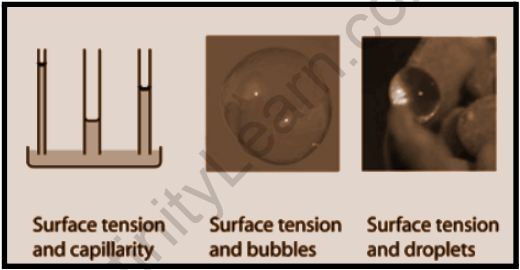Table of Contents
Introduction:
Surface tension is the property of a liquid surface to behave like a stretched elastic membrane. This phenomenon can be observed in small droplets and soap bubbles that are nearly spherical. This term is generally only used when the surface of a liquid is in contact with a gas such as air. When a surface is between two liquids (such as water and oil), this is called “interface tension”. Cohesive forces between liquid molecules are responsible for a phenomenon known as surface tension. Molecules on a surface bind more strongly to molecules that are directly bound to molecules on the surface because there are no other similar molecules on all sides. This forms a surface “skin” that makes it more difficult for an object to move across the surface than when it is fully submerged. Surface tension depends primarily on the attractive force between particles in a given fluid and gas, solid, or liquid in contact with the particles. For example, molecules in a drop of water are weakly attracted to each other. Water molecules inside a droplet can be seen as being equally attracted in all directions by surrounding molecules. However, if a surface molecule can move slightly outward from the surface, it will be pulled back by a neighbouring molecule. The energy responsible for the phenomenon of surface tension can be thought of as roughly equivalent to the work or energy required to remove the surface layer of molecules per unit area. Surface tension is measured as the energy required to increase the surface area of a liquid per unit area.
Overview:
Surface tension is a property of the surface of a liquid because the surface molecules have additional energy. Surface energy is the extra energy that molecules on a surface have. Because of molecules have extra energy, surface tension is a property of the liquid surface. Surface energy is defined as the surface energy per unit area of the surface of a liquid. Surface tension depends not only on the attraction between particles in a given fluid, but also on the attraction of solids, liquids, or gases in contact with them. The energy responsible for the surface tension phenomenon can be thought of as roughly equivalent to the work or energy required to remove the surface layer of molecules per unit area.
Surface tension is usually measured in dynes/cm, and dynes are required to break a 1 cm length of the film.
The surface tension of various liquids is given as:
| Liquid | Surface Tension (N/m) |
| Hydrogen | 2.4 |
| Helium | 0.16 |
| Water | 0.072 |
| Ethanol | 22.0 |
| Sodium Chloride | 114 |
The definition of surface tension tells us that surface tension depends primarily on the attraction between particles within a given fluid and the gas, solid, or liquid in contact with it.
Intermolecular forces, such as van der Waals forces, bring liquid particles closer together. Along the surface, the particles are attracted to the rest of the liquid. Surface tension is defined as the ratio of the surface force F to the length L on which the force acts.
Surface tension can be expressed as,
T=F/L
Here,
F is force per unit length.
L is the length in which the applied force act.
T is the surface tension of the particular fluid.
As the temperature increases, the net attraction between molecules decreases, and thus the surface tension decreases. At the surface of a liquid, the disproportionate attraction of molecules tends to attract the molecules back to the majority of the liquid, leaving only a minimal number of molecules on the surface. In an imbalanced situation, increasing the surface area of a liquid requires energy because more surface area contains more molecules.
Unit of Surface Tension:
The SI unit of surface tension is Newton per Meter or N/m.
The CGS (centimetre–gram–second system) unit of surface tension is dyn/cm.
Dimension of Surface Tension:
We have the formula for surface tension,
Surface tension =F/L
It is known that F= ma.
When substituting the value in the equation, we get
Surface tension=ma/L
When equating the fundamental quantities into the equation,
we get M L T-2L-1
Solving again,
we get MT-2
Thus, the dimensional formula of surface tension is MT-2.
Example of Surface Tension:
The strider, a small insect, is much lighter and can walk through the water’s surface, so it can walk on water. Therefore, there are various examples of surface tension found in nature. Here are a few cases:
- An insect that walks on water.
- A needle soaring on the surface of the water.
- Tent waterproofing material in which surface tension of water clogs pores in the tent material.
- Clinical trial for jaundice.
- Surface tension disinfectant (disinfectant is a low surface tension solution).
- Washing clothes with soaps and detergents that reduce the surface tension of water.
- Washing in cold water.
- Round bubbles in which the surface tension of water creates wall tension and forms water droplets.

Methods of Measurement:
Several methods of measuring surface tension are:
- Rotational Fall Method
- Suspension Fall Method
- Du Nooy-Paddey Method
- Du Noui Ring Method
- Wilhelmy Plate Method
Frequently Asked Question (FAQs):
Question 1: What is the dimensional formula of surface tension?
Answer: Surface tension has the dimensional formula [M L 0 T-2].
Question 2: What happens if a soap bubble is being charged?
Answer: If a soap bubble is charged, then it expands.
Question 3: What makes raindrops spherical?
Answer: The presence of cohesive forces among liquid molecules and the surface tension of the liquid is the reason behind the spherical look of raindrops.
Question 4: Which are the forces behind the origin of surface tension?
Answer: The cohesive force and adhesive force are considered as the forces behind the origin of surface tension.







